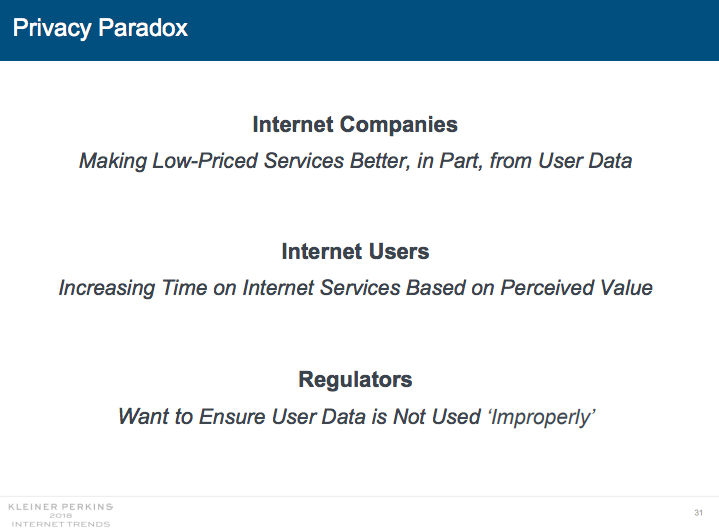It’s one of the most anticipated reports every year in the digital world and we’re ready to dive in and explore all the latest trends in media, advertising, e-commerce and new technologies.
Mary Meeker’s report (full presentation embedded at the end of this post) offers an extensive analysis of the latest trends in technology, media, advertising, but also in consumers’ changing habits, the shifts in the workspace and the global economic landscape. We’ve decided to take a closer look at all the stats to inform you about the trends you need to know. We’ve written the first part of the analysis which can be found here and here is the second part.
How social media contributes to the discovery process

Social media seems to play an integral part of the discovery process for new products with each platform serving different goals and audiences.
Facebook is the first option for consumers aged 18-34 in product discovery and Instagram and Pinterest follow. These three platforms seem to know how to blend awareness with consideration to turn a social presence into an actionable result. Moreover, 55% of respondents bought a product online after social media discovery, which justifies the ROI of social media when setting up a strategy.
These stats show how social media has reached a mature stage that allows them to go beyond the awareness to serve practical goals for a business.
There has also been a 6% growth of e-commerce referrals coming from social media, a statistic that is encouraging about the use of social media marketing for an e-commerce business.

Changes in Ad Spend
Facebook has seen an increase in ad engagement, with the CTRs for e-commerce growing by 3%. This has also increased the competition among advertisers, which led to a rise in cost for social ads. More specifically, Facebook’s eCPM has increased by 112% at the time when CTR has also increased by 61%. The stats are not surprising as more marketers explore the benefits of Facebook Ads and how they can be part of their digital strategy.
The better the results, the higher the competition will be from now on.

Moreover, marketers seem to be more interested in the customers’ lifetime value (LTV) as they now consider it their primary metric when measuring their ad performance. It goes way higher than impressions, traffic or brand recognition as it can help them measure their marketing impact in the longer term.

The rise of personalization and the privacy paradox

Personalisation has been increased across different apps and devices to provide better experiences for consumers. This has also helped brands grow their user base through a data-driven approach.
Facebook currently counts 2.2 billion users, Pinterest has reached 200 million monthly users, while subscription models turn into a big trend, with Spotify and Netflix enjoying their success.

However, there is also a privacy paradox that takes place. Internet companies, Internet users and regulators seem to have different goals and needs, which creates a confusion on the best way to find a balance.
As people spend more time on the Internet, they seek for increased value while they provide more data. Internet companies improve their services through the user data, while regulators are trying to control how the data is shared.
GDPR is another trending topic that made the discussion even more relevant and we’re expecting further attention to the way the data is collected and shared.
An increase in online advertising spend
The growing use of mobile devices has also brought an increase in the mobile advertising spend. There is an opportunity that is estimated at $7 billion in the mobile ad investment and more advertisers seem ready to experiment with it.
It’s not surprising that there is a drop in the TV usage, while there’s also a drop of the desktop usage, with mobile devices winning the ground of the other two.
This change makes marketers reconsider their content marketing strategy to ensure that their campaigns meet their target audience and their consumption habits.

A comparison between desktop and mobile advertising spend sees a big growth of mobile ads, while desktop advertising has been stable with only a slight growth. What’s encouraging is that all devices seem to have an increased advertising spend reaching a total of $88 billion.

Consumers have increased privacy concerns

Personalisation can lead to an improved customer experience but this doesn’t mean that consumers are not concerned about their privacy. 64% of the respondents deleted avoided certain apps while worrying about their privacy. Moreover, 47% of them adjusted their mobile privacy settings to feel more secure, while 28% have disabled their cookies.
This trend highlights the growing need for improved privacy. The recent Facebook scandal will probably affect more users to be alarmed with their privacy and most importantly, how they can feel more secure through a series of adjustments to their settings.

What’s positive is that more companies are willing to protect their users by introducing a series of tools to secure their data. Facebook and Google understand that there is a growing concern over privacy that needs to be addressed and they try to educate their users into being more mindful with their data.
What can we learn?
All these stats lead to some interesting observations that can help marketers adjust their strategies to maintain their success.
- Social media is no longer exclusively for awareness. It can lead to increased sales provided that you adapt your social media marketing strategy to facilitate it.
- The increased mobile consumption leads to an increase in the advertising spend for mobile devices. We may not abandon our desktop devices, but it’s still useful to allocate our budget accordingly from now on.
- Personalisation through data-driven strategies becomes more important than ever for consumers
- Data privacy concerns are growing and companies cannot ignore them
- It’s encouraging that more companies are interested in their users’ privacy
How are these stats help you improve your digital strategy from now on?
















